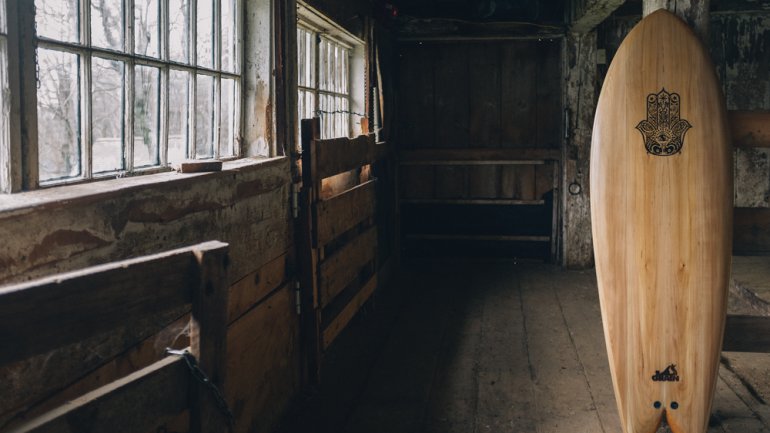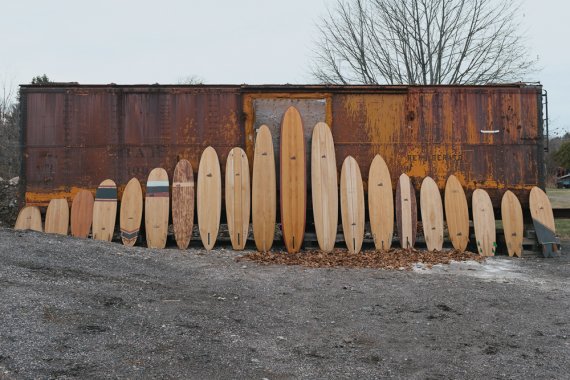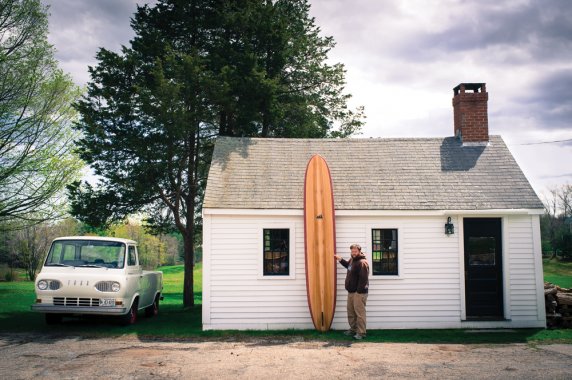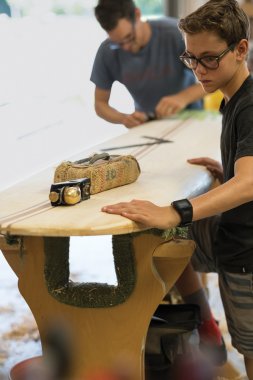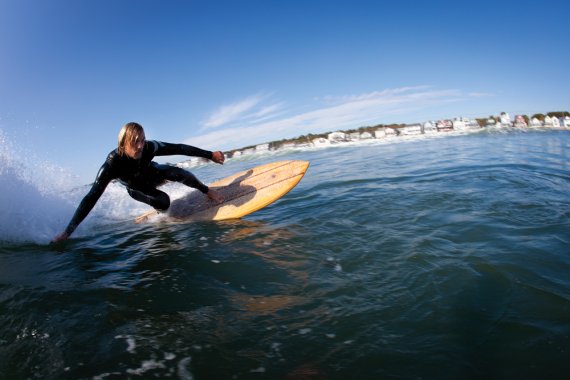Grain Surfboards
Grain Surfboards
Mike Lavecchia remembers the magic of his first job, at Burton Snowboards in Vermont.
“There was a door off the showroom for staff, and I was just inside, working this pneumatic press, rolling out rubber and stamping it,” he recalls. “To customers, that door was like looking into Oz, and when it opened, the first thing they saw was me.”
Now LaVecchia, 51, is a wizard of sorts in his own Oz: Grain Surfboards, the company he founded in 2005 in the coastal town of York, Maine. A devoted – some would say rabid – fan base of surfers reveres Grain’s handmade, hollow wooden boards for their beauty and brawn. Made from locally harvested northern white cedar planks, sometimes accented with reclaimed Western red cedar strips, the boards offer a more sustainable, less toxic alternative to the foam and fiberglass versions most modern surfers use. And unlike the smoke-and-mirrors wizard in Hollywood’s Oz, LaVecchia operates a wide-open business that offers do-it-yourself kits and board-building workshops.
The New Jersey native discovered surfing after feeding two earlier passions – snowboarding and sailing. In the 1990s, living in Burlington, Vermont, he started buying small sailboats; when he’d buy a “new” one, it was often older and in rougher shape than the one before. (“I’ve always loved working on boats as much as using them,” he declares.) He later captained charter sailboats and oversaw construction of an 88-foot replica 1862 wooden schooner at Lake Champlain Maritime Museum.
“I realized that the things I loved about boats all narrowed down to wood. I love the history and how they’re built by hand,” says LaVecchia, who lives year-round on a 45-foot wooden trawler docked in Kittery, Maine.
After friends introduced him to surfing, LaVecchia carried those same sentiments to surfboards and built his first one in York, where he and his youngest brother, Nick, now 43 and a photographer, had gone “for the summer” to be closer to the waves. They never left.
Grain got a big boost early on when a local article about the company was picked up by the Associated Press and ended up running in newspapers around the world. “Within a few days, we had six orders for boards; we’d only made six up until then,” says LaVecchia.
Grain added kit sales to expand the business, share design knowledge, introduce surfers to the joy of making, and promote the use of wooden boards.
“We talk about being advocates for wooden surfboards and being environmentally friendly, but we also knew our boards were relatively expensive, so we wanted to start selling kits so more people could ride and enjoy wooden boards,” says LaVecchia, who still surfs as much as possible.
LaVecchia adapted much of what he knew and loved about wooden boats to building the surfboards, also relying on the technical expertise of his staff, which varies from six to 10 people depending on the season. “We’ve invested a lot in 3D CAD technology and have built our own tools that help us to streamline the process.”
Grain sells about 50 custom boards a year, which take 40 to 60 hours each to make. Kit sales have fallen as class attendance has climbed. Workshops are held all year at Grain’s Maine base, elsewhere on the East Coast, and now and then on the West Coast. Last year, two alumni opened a Grain outpost on Long Island; they host regular weekend workshops.
“Classes have become the heart of the business, and we’ve really built a community around them,” says LaVecchia. “People have the satisfaction of making their own board and using it, and we get to see more wooden boards out there.”
The Swell Life
Full frame: While Mike LaVecchia was building surfboards, his brother, Nick, found his calling photographing them, in and out of the water. His images appear on Grain’s website and social media accounts.
Fervent followers: Grain has nearly 52,000 fans on Instagram, some 12,000 on Facebook, and more than 7,000 newsletter subscribers.
Gathering of the tribes: Grain’s annual Surf Re-Evolution event features likeminded companies and makers, surfing talks and demos, bands, beer, and a bonfire. Last year’s attendance topped 1,000.
